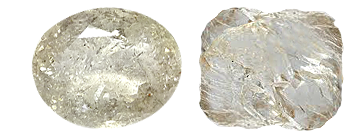 Photo of Oligoclase in Processed & Rough Form
Photo of Oligoclase in Processed & Rough Form
Oligoclase is a mineral with a hardness of 6 out of 10 on the Mohs scale of mineral hardness [?]. These Triclinicly structured gems are made of sodium calcium aluminosilicate, their full chemical compound being (Na,Ca)(Al,Si)4O8.
Oligoclase is a mineral of the plagioclase feldspar series, other members of which are Labradorite and Anorthite.
It forms as tabular crystals, which are commonly twinned, with parallel or criss-cross twinning striations. It appears as massive, granular, or compact. It may show brilliant reflections from inclusions.
It is light, transparent to translucent, with a vitreous luster and may come in the colors grey, white, greenish, yellowish, brown, reddish, or colorless, and has a white streak.
Oligoclase forms in many igneous and metamorphic rocks. The igneous rocks are plutonic and volcanic, and include acid granite and pegmatite, intermediate syenite, trachyte and andesite, and basic basalt. In metamorphic situations, oligoclase is formed in high grade, regionally metamorphosed gneiss and schist.
Oligoclase is found in New York, Maine, New Mexico, North Carolina (USA), Baffin Island (Canada), Sri Lanka, Brazil, Kenya, India, and Norway.
Gem varieties of oligoclase are uncommon but can be large. These include oligoclase Sunstone (sensu stricto), or oligoclase moonstone, and aventurine feldspar, due to microscopic inclusions of red, orange, or green very thin platy crystals of hematite or goethite or both, which caused the peculiar reflection of golden or brownish-red color known as aventurine or sunstone feldspar.
By common usage the name sunstone has come to mean any aventurescent feldspar, even those with compositions other than oligoclase. Those with oligoclase composition includes sunstone from: Norway - the best-known locality is Tvedestrand, near Arendal, in south Norway, translucent oligoclase with an orange/brown background colour containing small exsolved aligned hematite and/or goethite crystals; Russia - Chatoyant grey-brown perthitic feldspar from Vishnevye Mountains in the Urals, aventurescent oligoclase is also found at Verkhne Udinsk on the Selenga River near Lake Baikal, in Siberia; Oregon (USA) - where it is the official gemstone, large, brightly coloured transparent gems that occursin Lake and Harney Counties at the Plush area Dust Devil mine and Ponderosa mines; Tanzania - Light greyish green oligoclase sunstone from feldspar lenses in biotite schists at Engare Naibor, Arusha, contains eye-visible iridescent orange hematite platelets that produce a "confetti" sunstone effect.
Peristerite is the name given to iridescent albite-oligoclase lamellar intergrowths.
The term 'moonstone' has been applied to both peristerite and alkali feldspars with perthitic intergrowths that exhibit sheen.
Aventurine feldspar has a metallic glitter, which is red, less often green or blue. Its counterpart in the orthoclase feldspar series, Adularia, can frequently be seen with inclusions similar to aventurine with the same effects.
Oligoclase is often confused with aventurine glass or aventurine quartz.
The specific gravity [?] for Oligoclase is 2.64, it's refractive index [?] is 1.54-1.55, and it's double refraction [?] is 0.007.
History
The name oligoclase is derived from the Greek words "oligos" meaning small and "klan" to break, because it was thought to have less perfect cleavage than albite.
Industrial Usages
Aventurine feldspar, the most prominent gem variety of Oligoclase is cut with flat surfaces, or en cabochon. It is frequently cut as faceted gems from Bakerville, North Carolina, USA.
All members of the plagioclase feldspar series are used for ceramics, glazes, and basic refractories.





